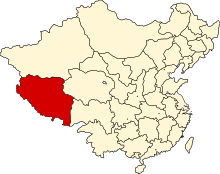Tibet_Area_(administrative_division)
Tibet Area (administrative division)
Former province-level administrative division of China
The Tibet Area is a province-level administrative division of China since 1950. It was created after the invasion of Tibet by the Republic of China (1912–1949), and nominally includes the Ü-Tsang (central Tibet) and Ngari (western Tibet) areas, but not the Amdo and Kham areas.[1][2][3] The territories were merely claimed by the ROC, but actually controlled by an independent Tibet with a government headed by the Dalai Lama in Lhasa. The ROC was defeated during the Chinese Civil War; it retreated to Taiwan and lost control of mainland China to the People's Republic of China (PRC) in 1949; afterwards, the ROC continued to claim Tibet.
You can help expand this article with text translated from the corresponding article in Chinese. (March 2022) Click [show] for important translation instructions.
|
The PRC annexed Tibet in 1951 and continued to call it Tibet Area.[4] It was transformed to Tibet Autonomous Region in 1965 after the 1959 Tibetan uprising.[5]
